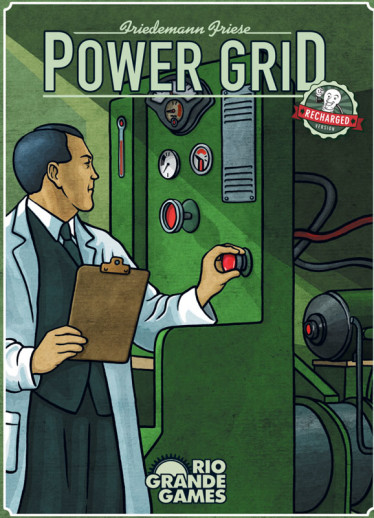We use cookies to make your experience better. To comply with the new e-Privacy directive, we need to ask for your consent to set the cookies. Learn more.
Power Grid: Recharged
What does it take to build and power cities while competing for capacity, resources and power grid locations? If you enjoy heavy, competitive strategic games with resource placement, auctioning and money management components, this game provides a satisfying balance of player interaction and planning. The objective of this game is to supply the most cities with power at the precise time that the end of game triggers. In this 2-6 player game, available power resources, game steps and game-end goals are dependent on the number of players. There are three steps in this game, each consisting of five phases, which are played repeatedly until the goal of each step is reached. These goals are determined by player count that are specific required numbers of connected cities on the grid. When goals are met, the next step commences. Once the third step's end game goal is reached, the game ends and the player with the most powered cities on the grid at that time wins the game. During each of these rounds, players call upon their strategic planning abilities to decide which power plants to purchase when bidding for them against other players in the auction phase. Next, they need to power their plants with coal, oil, garbage or nuclear resources. There are also eco-friendly renewable power plants that may be more expensive to purchase but do not require resources to provide power to a player's cities. Based on the turn order for each round, there may be opportunities to purchase additional resources at lower costs than may be available in the future. Different power plants have capacities to power various numbers of homes in the power grid and these plants need to be upgraded during the game to escalate the number of cities in total that a player can power up. At the end of each round, purchased resources are used to power up the optimum number of homes on the grid to add income for the next round. Although players are in a race to build the most powered-up homes at the end of the game, there is always a tight balance between when and how to spend their income each round. For example, purchasing a higher cost power plant at auction that can power more cities with fewer resources earlier in the game might result in less purchasing power to build cities in one round but give that player an advantage of capacity later on. Alternatively, purchasing additional resources that can be used to power cities in the next round while they are available for a lesser cost can also be an advantage. As the map populates with cities, remaining city locations are more expensive to purchase during the following rounds so it might be smart to snap up cheaper locations earlier even if you are not ready to power them up immediately. Watching what your opponents are doing can be valuable for strategy and planning purposes as each player juggles turns, money and resources to be able to power the greatest number of cities when the game ends. If you love the type of game that rewards analyzing every move, timing these moves and tightly managing resources, this is your game! For 2-6 players with 90-120 minutes of playing time.
What better way to earn money than with electric power?!! But how should you do it? Will you use old-fashioned coal or oil? Maybe you'll be at the forefront of burning garbage. Nuclear power is tempting, as long as you can acquire uranium. You can always be independent of resources if you go the ecological route. No matter how you decide to generate energy, you'll have to compete with other players for power plants and fuel. And then you'll compete again to be the first to connect to each city!
You'll need to watch your opponents closely, carefully manage your money, and expand your network thoughtfully to generate income. The player that can build the most extensive network AND successfully power it will be the winner.
Power Grid: Recharged has all the strategy and fun of the classic first edition but adds some updates that improve the (already excellent) game play.
| Product Format: | Other |
|---|---|
| Brand: | Rio Grande Games |
| Grades: | 8-AD |
| EAN/UPC: | 655132005593 |
| Length in Inches: | 14.5 |
| Width in Inches: | 10.75 |
| Height in Inches: | 2.125 |
| Weight in Pounds: | 2.8 |

